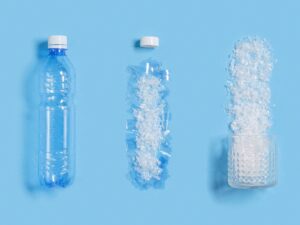Micro-plastics
Microplastics? What the heck? Another thing to worry about. It’s like industrial seed oils and artificial sweeteners weren’t scary enough. Our modern food culture had to come up with something else for us to be afraid of.
The term microplastics was first used in 2004 to describe small fragments of plastic. In 2008, the U.S. National Oceanographic and Atmospheric Agency (NOAA) defined microplastics as tiny pieces of plastic or other polymer-based materials, ranging from 5 millimeters (0.2 inches) to as small as 100 nanometers (small enough to be airborne), often called nanoplastics. These tiny particles contain a variety of chemicals that are harmful to humans.
Over the past few years, a considerable amount of research has confirmed the harmfulness of microplastics. But in March of this year, The New England Journal of Medicine revealed just how detrimental microplastics can be to humans, animals and the environment.

The study found that 58 percent of patients undergoing surgery to remove plaque from their carotid arteries had microplastics in their heart plaque. But, more importantly, the presence of microplastics in the heart was linked to a 4.5-fold increase in death, heart attack, or stroke.
The study got the attention of scientists, doctors, and the public. We cannot take the threat of microplastics to our health lightly.
How prevalent are microplastics?
We started manufacturing plastic in the 1860s, but not until World War II did the plastics boom really began. Now much of our world is plastic.
Microplastics are everywhere in our environment. A study published in 2023 sums it up by saying plastic is ubiquitous in air, water, and soil, especially due to the fact that packaging for almost everything we eat is made from plastic.
The presence of microplastics has been detected in soil ecosystems, lakes and streams, and sandy beaches. Aquatic ecosystems have been heavily affected to the point that it is almost impossible to consume any seafood without ingesting microplastics.
Scientists have found microplastics in snow in the Arctic, deep in the ocean, on island beaches in the middle of the Pacific, and high on the mountains of the Alps.
Where do microplastics come from?
We ingest microplastics from several paths including the food we eat, the water we drink, and the air we breathe. One of the most prominent forms of human exposure is plastic food packaging, which proposes a huge concern when you consider almost every food we eat is packaged in plastic. One study estimated a person’s annual exposure to microplastics from these sources:
-
- Food (total): 488,000 to 577,000 particles per year
- Drinking water: 220,000 to 1.2 million particles per year
- Air (total): 210,000 to 2.51 million particles per year
- Outdoor air: 46,000 to 210,000
- Indoor air: 160,000 to 2.3 million
Single use plastic bottles seem to be the biggest source of microplastic exposure. People who get their water exclusively from bottled water could be ingesting 20 times more microplastics than those who drink only tap water.
How do microplastics get in our bodies?

Most microplastics enter our bodies through the foods and beverages we ingest, but it’s important to understand that consumption isn’t our only form of microplastics exposure. Microplastics enter your body in three different ways:
-
- We eat or drink them when we consume foods or beverages packaged in plastic.
- We breathe them in. Microplastics are small enough to be airborne.
- We absorb them though our skin. One study found microplastics can enter our bodies through touch from things such as the clothes we wear or the chairs we sit in.
How can microplastics harm us?
We’ve only really known about microplastics since 2004, so we are just beginning to understand how they can impact health. Here’s a little bit of what we know.
Heart
The New England Journal of Medicine study mentioned earlier in this article found that the presence of microplastics in the heart was linked to a 4.5-fold increase in death, heart attack, or stroke.
Brain
A study that analyzed 91 human brain samples found that microplastics accumulate 10 to 20 times more in the brain than in other organs.
The same study also examined the brains of 12 people who died from dementia. Those subjects had ten times more plastics in their brains than people who did not have neurodegenerative disease.
Reproductive Health
Microplastics appear in human placenta. We also know that women who have higher levels of microplastics produce fewer eggs.
Men with higher levels of microplastics have decreased sperm concentration and lower total sperm count.
Cancer
A review of research on the relationship of microplastics to cancer found that microplastics could be a trigger for uncontrolled cell growth. Microplastics may be related to the propagation of various cancers, but more research is needed.
Don’t freak out yet.
We obviously live in a world where plastic is everywhere. It’s impossible to avoid. We know microplastics have a negative impact on our health, but so do a lot of other things we expose ourselves to on a regular basis. At this point, I’m convinced that sugar, industrial seed oils, and ultra-processed foods pose a much greater threat to our health than microplastics. But that doesn’t mean we shouldn’t try to eliminate microplastics when and where we can. More on that to come.
Stay Strong,
Bo Railey

